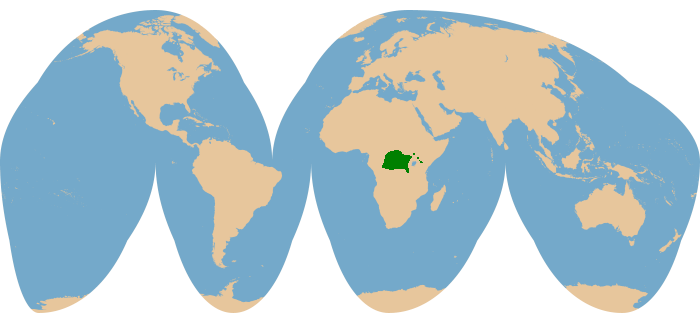Kingdom: |
Animalia Chordata Mammalia Artiodactyla Ruminantia Bovidae Cephalophinae Cephalophus |
Common name:
Scientific name:
Other names: |
Weyns's duiker
Cephalophus weynsi
Céphalophe de Weyns, Makpolo, Ange, Inge, Mongee, Mangele, Mungele, Mu`Nju |
Physical Characteristics
- Head and body length:
94-100 cm
- Shoulder height: 55 cm
- Tail length: 10-20 cm
- Adult weight: 15.9-19.5 kg
- Shoulder height: 55 cm
The overall coloration is chestnut brown or dull red with an olive tone; individuals from the eastern part of the species's range (subspecies C. w. lestradei and C. w. johnstoni) tend to be darker than those from Central Africa (C. w. weynsi). Eastern populations also tend to be smaller in size. In all populations, the underparts are paler and the legs are dark. The dorsal midline tends to be more darkerly colored than the rest of the body; in some individuals, this forms an indistinct dorsal stripe that lacks sharp borders. The front of the face tends to be chocolate brown, with a mixture of red and black hairs on the forehead; the forehead crest is well developed and bright red. Both sexes have horns, although those of females are always much shorter: 1/3 to 1/2 the length of those of males, whose horn bases are distinctly swollen. Typical horn length for males varies between 8.7 and 11.1 cm; female horn length is 3.3-5.5 cm.
- Similar species
- Weyns's duiker can be differentiated from the sympatric bay duiker (Cephalophus dorsalis) and white-bellied duiker (Cephalophus leucogaster) by the lack of a distinct dorsal stripe.
- The black-fronted duiker (Cephalophus nigrifrons) and Harvey's duiker (Cephalophus harveyi) are much more rufous and show no darkening along the back. Both also have a distinctive black blaze on the face.
Reproduction and Development
Nothing is known of the breeding habits or development of Weyns's duiker, although basic biology is likely similar to that of other red forest duikers. Juveniles have a speckled appearance due to individual hair banding patterns.
Ecology and Behavior
- Family group:
Solitary or in small groups of up to five animals.
- Diet: Mostly fruit (ripe, unripe, and seeds); also foliage, flowers, and fungi.
- Main Predators: Leopard.
- Diet: Mostly fruit (ripe, unripe, and seeds); also foliage, flowers, and fungi.
Habitat and Distribution

Conservation Status
- IUCN Red List:
Least Concern (2016).
- CITES Listing: Not listed (2017).
- Threats: Hunting is the principal threat; habitat loss to a lesser extent.
- CITES Listing: Not listed (2017).
The world population was estimated to be around 188,000 in 1999, based on density estimates. This species is hunted extensively, but appears to be relatively resilient to moderate hunting pressure.
